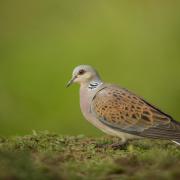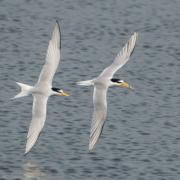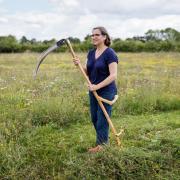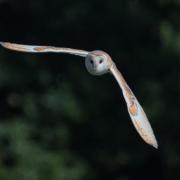It's still holiday time and our purple heaths and shimmering beaches are looking resplendent, but summer hasn't got long to go. John Grant tells us what to look out for in our countryside before autumn sets in
It’s still holiday time and our purple heaths and shimmering beaches are looking resplendent, but summer hasn’t got long to go. John Grant tells us what to look out for in our countryside before autumn sets in
August. The holiday hordes just love it, and rightly so. They are still sunning themselves (hopefully) on our Suffolk beaches and still thronging (definitely) our picturesque towns and villages.As welcome as they are to soak up a Suffolk summer, they had better make the most of it. Whisper it quietly. Very quietly. Autumn is inexorably on its way.The tell-tale signs we saw in July – the very first indications of southerly autumnal bird movement, with the northern waders already heading away from the fast-approaching Arctic winter – are even stronger now in this month we still refer to as high summer.High summer? For many birds – from a wider selection of families now than just the waders – it’s high time to move on. The hint of autumn now is ever more insistent. The seasons, just like this old planet of ours, turn and turn as time moves on.Ahead of us lies the migratory flood of September and October – two months of the year in which Suffolk birdwatchers dispense with lie-ins and head to the coast to witness dawn arrivals of globetrotting marvels.In August, naturalists experience a foretaste of the impending mass movements of northern warblers, flycatchers and chats – but they experience the full glories of the wader movements that got under way in July.The forerunners of this wader spectacle were the adults that left behind their “partners” and their eggs and chicks to clear out early from the Arctic expanses. Now, in August, we have another wave. The adults that were left behind to incubate eggs and rear their chicks – and the juveniles themselves, for the first time undertaking what will inevitably be an arduous southerly journey in some case of many thousands of miles.The fact that these incredible travellers criss-cross the globe inevitably means that sometimes, either as the result of weather patterns or slight aberrations in the birds’ navigation, things can go wrong. Instead of, say, travelling south from the Arctic wilds of Canada to the Patagonian flatlands, a few degrees of miscalculation means a buff-breasted sandpiper, for example, can end up on the wrong side of the Atlantic and provide a real treat for a Suffolk birder.Conversely, a great knot – to give another arbitrary example – that is meant to be heading south from Siberia to Australia can “take a wrong turn” and end up in Britain.Such a discovery always provides a thrill for a British observer. Indeed, some “twitchers” exist purely for the adrenaline rush of haring off to see another “tick” for their list. It take all sorts, of course, but some of the more fanatical “listers” seem to miss out on so much sheer joy that can be obtained from the simple, bread-and-butter, day-to-day occurrences.In August these come thick and fast as the waders pour into our wetlands – sadly, however, we are seeing increasing levels of drought during August and many such once-wet havens can turn into virtual deserts.If a Suffolk birder’s “local patch” is somewhat drought-stricken, with just a puddle or two left, there is plenty of scope for branching out and looking for other forms of wildlife. Our old friend Peter Lawson suggests: “August is traditionally a month for visiting the seaside, so do look out for the blue-flowered and very prickly sea holly which can occasionally be found along the coast.“It used to be dug up for its fleshy roots, which were candied to make a sweetmeat in past centuries, probably resulting in its scarcity nowadays! Yellow horned poppies will still be in flower on the shingle beaches.“The saltmarshes in the tidal estuaries are now a haze of purple from massed sea lavender, interspersed with taller sea asters, some with lilac petals, but others with only the yellow centres.“As you approach the coast, you may well cross part of the Sandlings heaths which stretch intermittently from Lowestoft to Felixstowe. Some areas, such as Dunwich Heath, are golden-yellow with the flowers of the low-growing western gorse, ironically only found in the east of Suffolk. This is a different species to the generally tall, woody shrubs of the common gorse, which is widely distributed across the county and is in bloom from autumn to early summer. “The ling or heather creates another haze of mauve on Dunwich Heath, which is managed by the National Trust, where some of the very low-growing deep pink bell heather will still be in flower.”It is not just botany that provides summer delight for the Suffolk naturalist, however. Although water levels may be down, there is sure to be a fine array of dragonflies and damselflies to enchant us. And quite apart from the more familiar species, as if they are not exciting enough, we are seeing in Suffolk a veritable invasion of scarce migrant species from the Continent, tempted to our shores by the effects of climate change and finding Suffolk very much to their liking once they get here, thanks to our impressive network of nature reserves and the improved water quality in the countryside in general.Crossing the North Sea recently have been wanderers such as red-veined darter, yellow-winged darter, lesser emperor and southern emerald damselfly. The latter’s close relative, the willow emerald, has really burst on to the scene with colonisation apparently taking place at a rare old rate in the south of the county.All these wildlife wonders can make August a terrific time to be out and about, even if autumn is on the horizon. Come to think of it, why be worried about autumn’s onset? Autumn? That’s another season in which wildlife can enthral us – and in some ways it’s even better than summer. If August has given us a taste for the study of migration – and it certainly should have done –- we can really immerse ourselves in such wonders in September!
Now's the time to see...
SMALL RED-EYED DAMSELFLY: Eyes like redcurrants, a body of dazzling blue and jet black, this little wisp of wetland life has positively burst on to the scene in recent years. First discovered in Britain in Essex as recently as 1999, after several years of Continental range expansion, there was a huge influx in 2001 and the rest, as they say, is history. Now it is well-established in Suffolk on lakes and ponds with floating vegetation at coastal and inland sites. It takes a bit of identifying however, as it is similar to the more familiar red-eyed damselfly – get a good field guide and rise to the challenge!


























